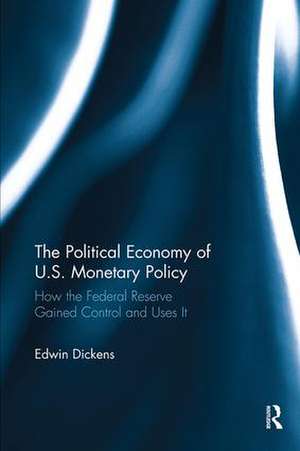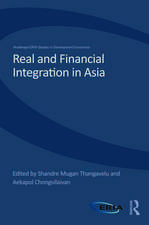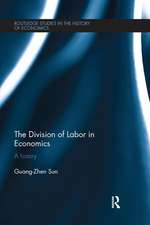The Political Economy of U.S. Monetary Policy: How the Federal Reserve Gained Control and Uses It
Autor Edwin Dickensen Limba Engleză Paperback – 22 ian 2018
In this book, Dickens explains how flexible exchange rates became necessary to accommodate the Federal Reserve’s relentless efforts to prevent progressive social change. It is argued that the Federal Reserve is an institutionalized alliance of the large New York banks and the large regional banks. When these two groups of banks are united, they constitute an unassailable force in the class conflict. However, when the large regional banks are at loggerheads with the large New York banks over the proper role of bank clearinghouses during the populist period, along with the proper role of the Eurodollar market during the social democratic period, there is an opening for progressive social reforms.
This book builds upon Hyman Minsky’s financial instability hypothesis as well as the Marxian model constructed by Thomas Piketty. It follows Piketty’s historical method of deepening our understanding of the current Neoliberal Era (1980-2014) of global financial capitalism by comparing and contrasting it with the first era of global financial capitalism—the Gilded Age (1880-1914). In contrast with Piketty, however, this book incorporates monetary factors, including monetary policy, into the set of determinants of the long-run rate of economic growth. This book is suitable for those who study political economy, banking as well as macroeconomics.
| Toate formatele și edițiile | Preț | Express |
|---|---|---|
| Paperback (1) | 309.10 lei 43-57 zile | |
| Taylor & Francis – 22 ian 2018 | 309.10 lei 43-57 zile | |
| Hardback (1) | 848.93 lei 43-57 zile | |
| Taylor & Francis – 15 mar 2016 | 848.93 lei 43-57 zile |
Preț: 309.10 lei
Preț vechi: 354.95 lei
-13% Nou
Puncte Express: 464
Preț estimativ în valută:
59.14€ • 61.92$ • 48.94£
59.14€ • 61.92$ • 48.94£
Carte tipărită la comandă
Livrare economică 07-21 aprilie
Preluare comenzi: 021 569.72.76
Specificații
ISBN-13: 9781138495463
ISBN-10: 1138495468
Pagini: 196
Ilustrații: 4
Dimensiuni: 156 x 234 x 10 mm
Greutate: 0.29 kg
Ediția:1
Editura: Taylor & Francis
Colecția Routledge
Locul publicării:Oxford, United Kingdom
ISBN-10: 1138495468
Pagini: 196
Ilustrații: 4
Dimensiuni: 156 x 234 x 10 mm
Greutate: 0.29 kg
Ediția:1
Editura: Taylor & Francis
Colecția Routledge
Locul publicării:Oxford, United Kingdom
Public țintă
Postgraduate and UndergraduateCuprins
Introduction 1. The Theoretical Framework 2. The Origin of the Federal Reserve System: The Institutionalization of the Alliance Between the Large New York Banks and the Large Regional Banks 3. Democratic Control Versus Banker Control of the Federal Reserve System 4. The Federal Reserve’s Implacable Opposition to Social Democracy 5. The End of the Golden Age of Relatively Stable Capitalist Development 6. The Eurodollar Market and Flexible Exchange Rates: The Linchpins of the Current Neoliberal Era of Global Financial Capitalism 7. Summary and Conclusions
Descriere
In book explains how flexible exchange rates became necessary to accommodate the Federal Reserve’s relentless efforts to prevent progressive social change. It is argued that the Federal Reserve is an institutionalized alliance of the large New York banks and the large regional banks. When these two groups of banks are united, they constitute an unassailable force in the class conflict. However, when the large regional banks are at loggerheads with the large New York banks over the proper role of bank clearinghouses during the populist period, along with the proper role of the Eurodollar market during the social democratic period, there is an opening for progressive social reforms.














